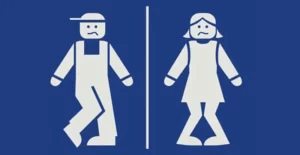Steven Soifer and Richard Ziprin, University of Maryland
As many as 20 million men and women (7% of the population) in the United States and Canada suffer from an affliction known to few professionals. Moreover, as many as 1 to 2 million people in these two countries are so debilitated by this ailment that their lives are severely disrupted. Nonetheless, physicians and therapists often fail to recognize the disorder, don’t take the patient’s problem seriously, and/or often offer inappropriate advice and help.
This affliction is called paruresis, or avoidant paruresis, and is commonly referred to as shy (or bashful) bladder syndrome, Until recently, there was very little hope for alleviating the symptoms of this social phobia. Now there are effective treatment strategies that offer hope to many who cannot urinate in public restrooms or in a variety of social contexts, including the mere presence of a visitor in an adjacent room in their home.
Public awareness about paruresis as an anxiety disorder is where knowledge of agoraphobia and other social phobias was 20 years ago. Slowly, the word is getting out about this condition, including some press coverage about paruresis in the last few years as well as the formation of the International Paruresis Association (IPA; 1-800-247-3864), a national membership organization dedicated to helping raise public awareness and effective treatments for paruresis, Now there is a very active website for paruresis, which for some is the only contact they have with others suffering from this affliction (www.paruresis.org).
What Are the Effects of Paruresis on
an Individual?
Parucetics are unable to urinate, or experience difficulty urinating, in public restrooms, or even their own homes if others are present. While many of us have experienced this occasionally, someone with paruresis experiences it all the time. Consequently, it can moderately or severely interfere with a person’s life. For instance, after an initial unpleasant experience, the individual anticipates difficulty urinating whenever entering a lavatory, A forced attempt to control the process fails, and associated
Page 1
anxiety then reduces the individual’s chances of voiding while in a public facility. The paruretic must then adjust to the disorder by voiding as much as possible when at home, restricting the intake of fluids, locating vacant public restrooms, and refusing extended social invitations (Zgourides, 1987).
Thus, parures engage in avoidance behavior that, while reducing the fear associated with an inability to void in a public restroom or other circumstances, ends up reinforcing the phobic pattern, While many parure-tics deny feeling any overt anxiety in public restrooms and insist that they merely can’t initiate micturition, others do report physiological components including heart palpitations, sweating, feeling faint, shaking, and dizziness. In addition, paruretics often report cognitions that have often been related to performance anxiety: Will someone come into the bathroom? Is someone watching me? Will someone hear me? Is there something wrong with me or my peers or my vagina?
Many paruretics encounter difficulty functioning in the workplace, particularly in cases where periodic urine screens for drugs are required. Also, traveling can be difficult, especially on long plane rides. Finally, social lives are severely compromised by this disorder.
Because this topic is rarely discussed publicly, many paruretics feel that they are alone in their suffering. They often feel ashamed of their disorder and become superb at hiding it from even their closest friends, spouses, and even their physicians. Based on anecdotal data, some individuals apparently find the sense of shame, isolation, and secondary depression debilitating.
Winter 2000
Page 2
What Is the Etiology
of Pasruresis?
There are many questions still to be answered about the etiology of paruresis. Parutesis may start very early in life, in preschool, early or late adolescence, or even mid to late adulthood. While some parure-tics cannot point to any specific triggering incident, others report the occurrence of some form of the traumatic incident prior to adolescence that seemed to trigger the phobia. These incidents often involve being embarrassed by a parent or classmates in school, teasing by siblings, harassment in public restrooms, or sexual abuse. Given that many children growing up experience such incidents (e.g., being teased by peers while trying to use a public toilet or urinal) and not everyone becomes paruretic, we speculate that some people appear to be “hard-wired” or have a biological propensity to develop paruresis. Such individuals may develop the condition based on a one-trial-learning episode. Why this is so, we don’t know.
Others have speculated that paruresis is 2 form of obsessive-compulsive disorder (OCD). While we believe that paruresis is first and foremost a social phobia, reports from clients that they constantly worry that people will hear or see them go to the bathroom suggests the possibility of an OCD component.
Regardless, it must be recognized that the inability to void is not within the conscious control of the paruretic. Therefore, the patient will often be forced to endure long, painful work hours during which voiding is impossible. Forcing liquid intake or suggesting increased liquid intake to these individuals are acts of cruelty that must be avoided but that are unfortunately sometimes recommended by well-meaning individuals who do not understand this ailment.
Is There an Effective Treatment
for Paruresis?
While some people with paruresis have sought therapeutic treatment, attempted cures are varied. Based on the poignant stories of many individuals on the paruresis website, it seems that many of those who sought treatment were not helped. However, we must stress that there have been no controlled treatment studies for paruresis.
Joseph Himle at the University of Michigan Anxiety Disorders Program has developed a cognitive-behavioral treatment approach that appears promising. Clients engage in an average of nine graduated exposure treatment sessions, Of 26 clients created, 8% have reported no change, 15% reported partial
Page 3
change, 31% reported moderate change, and 46% reported marked change. Follow-up data revealed that 42% worsened, 15% remained the same, and 43% showed continued improvement. Steven Soifer recently implemented this approach in a week-end workshop format. Based on 27 cases, pre- to post-test results indicate that the workshop participants rated their improvement as 5% a little, 15% some, 43% a lot, and 35% enormously, Moreover, participants maintained these gains at 6-month follow-up.
Other approaches that have shown some positive results include adjunct drug therapy, paradoxical intervention, hypnotherapy, and self-catheterization (see Zgourides, 1987). Teaching a patient self-catheterization provides an immediate way for the person to improve their ability to live life to its fullest, and the minimal risks result in many parure-tics viewing this as an attractive option.
After reviewing the relevant literature, communicating with more than 1,000 afflicted individuals, and conducting several desensitization workshops, we believe that the best role for a treating physician is to
- make certain there is no underlying physical ailment;
- teach the patient, if he or she so desires,self-catheterization; and
- refer the patient to a specialist in anxiety disorders for cognitive-behavioral therapy with graduated exposure (see Soifer, Zgourides, Himle, & Pickering, 2000).
The graduated exposure procedures are relatively simple. The client comes to his or her session with a full bladder. Water, or in some cases Lasix (a diuretic), is used to enhance urgency. The therapist works with the client to gradually expose him or her to the feared situation. Work begins with the client being locked in a private bathroom in the therapist’s office. The therapist stands outside the bathroom and the client is instructed to urinate for a 3-second interval. He or she may take up to 2 minutes. If successful, the therapist moves a little closer to the client, perhaps cracking the office door open. This graduated exposure procedure is repeated about 15 to 20 times in a 50-minute session.
If at any point during the session, the client is unable to urinate, then the therapist moves back to the location of the last successful trial, Then he or she tries again. The point of the graduated exposure is never to have the client move beyond his or her tolerance level. Given that the client’s avoidance behavior has usually built up over many years, flooding should be avoided. It seems essential for
Page 4
the client to take small steps toward the goal of reducing his or her anxiety enough to successfully urinate.
The client works with the therapist in this way until he or she is able to urinate with the therapist in the bathroom alongside the client, perhaps even making noise or hurrying up the client. At this point, the client is ready to go out with the therapist to an isolated public restroom, then to a semipublic restroom, and eventually to a public restroom. Toward the end of therapy, the client usually goes with the therapist to a busy interstate rest area or airport.
Based on a very limited sample, it also appears that some paruretic sufferers may benefit from adjunct drug therapy. For a few, a selective serotonin reuptake inhibitor (Paxil) helped to reduce anxiety levels enough that graduated exposure therapy worked. Although it is important to note that the effectiveness of any drug therapy in helping people with paruresis is purely conjectural at this point, psychopharmacological interventions may help the patient deal with the emotional problems brought on by the daily battle to live life with paruresis.
The Future
Much work on the etiology, prevalence, and treatment of paruresis is needed. For example, is paruresis a social phobia, simple phobia, and/or OCD, and for whom? Is there a neuropsychological component to this disorder? Is there a physiological component to this condition (a hypersensitivity to adrenaline or an overly tight bladder neck muscle)? Will one treatment model fit all> How useful, if at all, is adjunct drug therapy?
Like impotence and incontinence, paruresis creates feelings of embarrassment and shame for sufferers of the disorder. Nevertheless, It is probably the second most common social phobia, after the fear of public speaking. There is virtually no public awareness of this social anxiety disorder and very little recognition by the medical and mental health communities, Our hope is that this will change in the new millennium.
References
Soifer, 8. D., Zgourides, G., Himle, J, & Pickering, N. (2000). Shy bladder syndrome: Your step-by-step guide to overcoming paruresis, Oakland, CA: New Harbinger,
Zgourides, G. D. (1987). Paruresis: Overview and implications for treatment. Prychological Reports, GO, 1171-176.
the Bebavier Therapist










+ There are no comments
Add yours